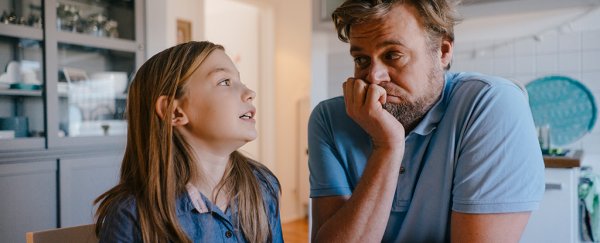Writing classroom resources on climate change told me a lot about how children – and teachers – view themselves in an uncertain future, like the one we're currently facing as the spread of COVID-19 accelerates around the planet.
While putting together a national climate change program more than a decade ago, I was given a word of 'advice' by one experienced teacher who recalled her own school days when the promise of an atomic winter was never far from mind.
"We were told to climb under a desk," she said while I surveyed her staff on the anxiety their classes felt over global warming.
"Dropping to the floor was never going to save us if bombs dropped, but it was sure better than telling us to just close our eyes and hope for the best."
Thankfully education has come a long way since the cold war. But she did have a point, of sorts – it's important I provide the right amount of information framed by the right amount of optimism when talking to kids.
Say too little and problems appear trivial. Too much, and a young audience is paralysed by the sense that nothing they do will make much difference.
Whether it's nuclear war, climate change, or a pandemic, parents and teachers face a serious challenge when it comes to communicating big risks to tiny humans. And it's a juggling act that can be hard to get right.
Here are a few tips that just might help.
Be honest. Be appropriate.
Five-year-old brains find it hard to grasp climate models, epidemiology, and large-scale politics. But avoiding the issue until they're a teenager doesn't give them behaviours or beliefs that can be built upon as they go, either.
The key is to start with what they know and use it as a scaffold, adding facts and possibilities based on familiar experiences and language while taking their questions as cues.
Monique Robinson is a registered psychologist and child health researcher at the Telethon Kids Institute. She also has a few words of advice herself when it comes to helping our children navigate the current COVID-19 pandemic.
"Keep it simple for young kids and provide more detailed information for older kids, but always keep the message as positive as possible in terms of what the world is doing to try and stop the virus spreading," says Robinson. She advises teaching them about how germs spread and how hygiene can stop that as a good starting point and building from there.
Keep calm. Keep positive.
With a constant stream of confusion over social media, climbing death tolls, and dire predictions of worse to come, we can all feel our pulses quicken and emotions rise.
Scream into a pillow if you must. Or better yet, chat with your colleagues and co-parents. But when sharing what you know with your kids, it's vital to stay positive.
Keep the conversation to practicalities while remaining objective, avoiding stigmatising or moralising language, especially about other social groups or cultures.
"Find out what they know, ask open-ended questions and address any excessive fear or misinformation that may be circulating around the playground," says Robinson.
This doesn't mean brushing off their concerns. But by linking questions back to real actions that authorities and communities are doing to mitigate risks, you can maintain a sense of control and optimism.
Be a model. Be a star.
If a picture is worth a thousand words, an action is worth a million. Telling kids to practice good hygiene while you're busy picking your teeth makes for a less than convincing conversation.
Help your kids by improving your own practices, whether that's washing your hands or getting better at sharing the child-friendly resources you've come across that explain complex information. Show as well as tell.
"For older kids, teach them about media literacy, how to find reputable sources of information, which sources to trust and how to identify non-evidence-based information," says Robinson.
"It's useful for many purposes, not just coronavirus."
Stay flexible. Stay alert.
While we're all smarting over cancelled holidays, closed schools, and empty supermarket shelves as the pandemic spreads, we sometimes downplay the dismay kids face over closed theme parks or the ending of sports seasons.
Disappointment is a legitimate emotion, no matter what we're missing out on. The important thing is learning how to respond and manage our expectations.
"Promote the silver lining – people are working together, we are all looking out for each other, we are taking care of the most vulnerable in our society, we are keeping the germs away as best we can!" says Robinson.
In some cases, it might be fair to renegotiate the usual rules in light of changing conditions. While it's important to maintain a life as close to normal as possible it pays to be flexible, extending screen time or finding new ways for kids to socialise with friends.
Those signs of anxiety, disappointment, and even fear might not be easy to spot, either. We all show our emotions in a variety of ways, and kids are no exception.
Look out for changes in eating and sleeping habits, odd variations in mood, or social withdrawal. If in doubt, chat with your family doctor, and maybe have a few words with their teacher.
There's no script you can read from that will tell you what to say to your students or children, unfortunately.
Luckily we can do a lot better than to tell them to just close their eyes and hope. Trust them. They're tougher than you think.
